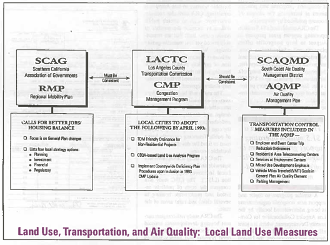By Larry J. Kosmont and Edric F. Guise. Kosmont is President of Kosmont and Associates, Inc., a real estate consulting firm that specializes in entitlement sand public/private real estate transactions. Guise is the CMP Private Sector Liaison for the L.A. County Transportation Commission.

LACTC’s Congestion Management Program (CMP) creates a new opportunity to translate regional goals into local land use actions.
The world of land use entitlements has entered the era of transportation and air quality coordination. Cities and landowners are no longer dealing with land use policies just from a local perspective but must also consider the regional impact of projects. Involvement of regional and county agencies in the entitlement process is the result of federal and state statutes enacted to address these “quality of life” issues that transcend local boundaries.
The new regional “entitlement players” are the South Coast Air Quality Management District (AQMD), Southern California Association of Governments (SCAG) and Los Angeles County Transportation Commission (LACTC). These agencies work together closely in developing their respective policies and work with local jurisdictions on how to blend regional concerns into local entitlement processes. Since these requirements are here to stay they will continue to be a factor affecting local land use decisions.
There is a great deal of history to this transportation/air quality coordination issue. AQMD has been nibbling at land use policies by reviewing large projects through the Environmental Impact Report (EIR) process. Porter Ranch was an example of this type of review and other large projects can anticipate a similar level of scrutiny. Also, AQMD’s Regulation XV has started to affect location decisions of tenants, since employers are recognizing the advantage of locating in transit accessible commercial pockets.
SCAG’s Regional Mobility Plan and related jobs/housing balance strategy are important policy directives that have evolved significantly. Finally, both SCAG and AQMD are developing a number of land use related transportation control measures (e.g., local General Plan Air Quality Elements, mixed use development emphasis) that are included in the Air Quality Management Plan.
Within this context, LACTC’s Congestion Management Program (CMP) creates a new opportunity to translate regional goals into local land use actions. This program, which must be consistent with regional plans, works toward developing solutions tailored to L.A.’s unique needs and characteristics.
What is the CMP?
State law requires the CMP to be adopted in 31 urban counties throughout California. To avoid the loss of major transportation funding sources, counties must adopt a CMP by December 1, 1992. LACTC is scheduled to adopt its version of a CMP this November. For the 89 cities in Los Angeles County, the CMP establishes a land use analysis process to enhance the approval of projects that integrate regional congestion relief and air quality solutions. Cities must adopt CMP land use and Transportation Demand Management (TDM) measures by April 1993 in order to remain eligible for state and federal transportation funding.
The CMP requirement was enacted by voters with their approval of the June 1990 State gas tax increase (Proposition 111). One of its strengths as a policy directive is that, prior to the vote, the CMP survived intense negotiations between the environmental and business communities. A primary objective of the CMP, pursuant to State law, is to coordinate the investment of tax dollars toward effective and productive transportation and congestion relief improvements. This is to be accomplished by among other methods, enacting a project review process that focuses on addressing countywide transportation needs, preventing the problems generated by long commutes, and ultimately the economic and social blending of land use with the public’s investment in transportation.
Over the past two years, LACTC has developed a CMP that, has integrated the comments and concerns of both the business community and local jurisdictions. Favorable to the business community, there is no CMP fee and there are no plans for such a fee in the future. To a great extent, this is due to LACTC’s political sensitivity to the current economic climate. Favorable to local jurisdictions, the CMP utilizes existing EIR and planning processes to minimize implementation costs and staff burdens while still meeting the CMP’s goal.
Furthermore, California must achieve Federal and State Clean Air Act standards by 2010 and the region must improve the productivity loss from congestion if it is to survive economically. This means that to be effective in its support of these goals, the CMP will eventually need to be a more creative “entitlement player.” LACTC is currently conducting a Countywide Congestion Study to address future congestion problems. This study will include recommendations to provide incentives for land use strategies that reduce trip generation.
Thus, the new CMP marks the beginning of regional policy suggestions to local cities, landowners and tenants— a direction which the CMP will need to expand over time. The first year CMP has focused on defining a basic, core program, consistent with statutory requirements. As this program must be updated biennially, LACTC will build on this core program as it gains implementation experience. The following is what the CMP presently calls for relating to land use.
CMP’s Land Use Impacts
Among other requirements, State law mandates that the CMP contain a TDM element and a Land Use Analysis Program. By April 1993, localities must incorporate these key components of the CMP into their land development entitlement processes. As motivation to implement the TDM and Land Use Analysis Program components, the law states that local jurisdictions must satisfy these basic requirements or face withholding of transportation monies.
The Land Use Analysis Program requires local cities to adopt a program that introduces the analysis of land use impacts in the context of the regional transportation system. Heretofore, EIR transportation analysis of proposed developments typically has focused on local, rather than regional, impacts. To minimize impact to entitlement processes, the CMP’s Land Use Analysis program blends with existing CEQA requirements by providing a framework for regional impact analysis.
In order to achieve consistency with CEQA, the CMP provides cities with simplified transportation impact analysis guidelines whenever an EIR is required for a project. The guidelines require that project EIRs identify impacts on the CMP highway system, coordinate with transit providers and adjacent jurisdictions, and, as required by CMP law, identify costs of mitigation programs, as well as a project’s fair share of those costs.
Local jurisdictions will have to adopt these guidelines into their EIR process either by ordinance or resolution. However, the CMP does grandfather projects that have already circulated an EIR Notice of Preparation prior to local adoption of the CMP Land Use Analysis Program.
With an eye toward the public’s investment in transit, the CMP has been revised to encourage development next to rail stations. The statute was recently amended to exempt projects including high density residential development located within a quarter of a mile from a fixed rail passenger station, so long as the project exceeds 20% the maximum residential density allowed under local law. Also exempted is traffic generated by low- and very-low-income housing.
Even more interesting, under certain conditions, mixed-use projects are exempted if located within a quarter of a mile of a transit station. As a preview to the CMP’s impact on local land-use regulations, it should be noted that most of the County’s 89 cities do not have a mixed-use ordinance. Therefore, for projects to be exempted, local communities have a new incentive to adopt a mixed-use zoning category as part of their land-use element.
New TDM Requirements
Another CMP policy that relates to local land use is the TDM element. TDM pertains to policies that reduce peak hour automobile trips by promoting alternative transportation methods such as carpooling, vanpooling, transit and bicycling.
This component of the CMP complements the efforts of AQMD’s Regulation XV, which, in accordance with the State Clean Air Act, is pursuing the goal of average vehicle ridership (AVR) of 1.5 passengers per vehicle by 1999. Regulation XV only applies to employers of 100 or more.
However, the TDM element of the CMP will reinforce AVR and trip reduction strategies for employers by encouraging the design of “TDM-friendly” facilities. “TDM-friendly” refers to features of new buildings that promote and encourage travel modes other than driving alone.
To assist cities, LACTC developed a model TDM ordinance to ease local implementation of TDM requirements. The model TDM ordinance establishes a minimum level of trip reduction strategies that cities must adopt and apply to new non-residential projects. In developing the model ordinance, LACTC incorporated policies that support both SCAG’s Regional Mobility Plan and AQMD’s Air Quality Management Plan. This coordination should help avoid confusion about differing TDM efforts and their resulting impact on the entitlement process.
The model TDM ordinance applies to non-residential developments, and contains three thresholds for inclusion of transportation design features: 25,000, 50,000 and 100,000 square feet. Projects falling into these categories are required to provide features that support carpool, vanpool, transit and bicycle travel. In a nutshell, the requirements for new nonresidential buildings are:
- Developments over 25,000 square feet must provide a Transportation Information Area (i.e., a kiosk display case).
- Developments over 50,000 square feet must provide, in addition to No. 1 above, preferential parking for carpools and vanpools, access for van pools in parking areas, and bicycle parking facilities.
- Developments in excess of 100,000 square feet must provide the items included in Nos. 1 and 2 above, plus carpool and vanpool loading zones, direct access for pedestrians, bus stop improvements, and direct access to bicycle parking facilities from the street.
Monitoring and enforcement are left to the local jurisdictions through their existing procedures. Because the model TDM ordinance is design related, and not operational in nature, local cities are likely to meet this requirement by incorporating the model TDM ordinance into their design guidelines.
It is anticipated that when planners, architects and developers submit their site plans to a local agency, the agency will simply review TDM requirements as part of the local “checkoff” process. This “check-off” process already exists in most cities for other design and site plan requirements.
This initial TDM plan is recognized by all as a “Phase I” program. Unlike AQMD’s Regulation XV, these “Phase I” TDM guidelines do not impose ongoing operational requirements on employers. LACTC’s anticipated TDM “Phase II” program of the future is likely to address tougher issues that will undoubtably affect landlords and tenants. These issues include project design that supports jobs/housing balance goals and other operations oriented strategies such as flexible work hours, telecommuting and parking management.
Future CMPs
In the next few years, the CMP “entitlement player” will have much more for us to consider. In 1993, the CMP update will include the results of LACTC’s Countywide Congestion Study. This study will establish congestion conditions and necessary mitigations to the countywide highway system (approximately 1,000 miles of streets and freeways).
The study will become part of the technical baseline for a Countywide Deficiency Plan process. This process focuses on alleviating congestion problems on those portions or the CMP highway system that do not operate at an acceptable level of service.
While there is a significant level of public funding to help in the congestion relief effort, the road system has limited capacity. From both a public and private cost perspective, this makes the implementation of TDM trip reduction strategies even more important, simply because reduced peak hour trips can avoid expensive physical road improvements.
Accordingly, LACTC will look to develop countywide incentives that will encourage local land use decisions supportive of projects built close to transit stations and along the major transportation corridors.
As for land use in Southern California, the old real estate adage of “location, location, location” now appears to be shifting toward “location, transportation, air quality.” Keep an eye on the new land use “entitlement players” and stay tuned.
- Log in to post comments




